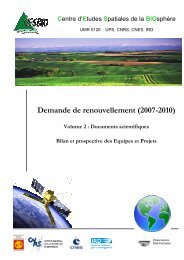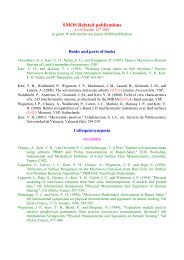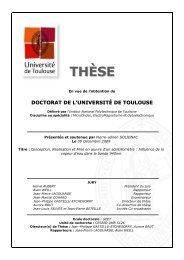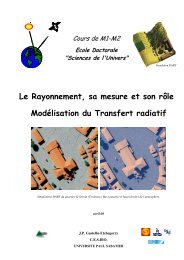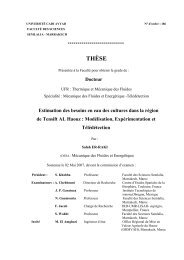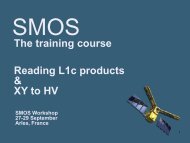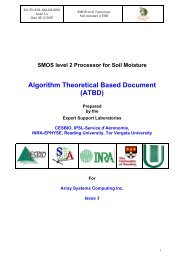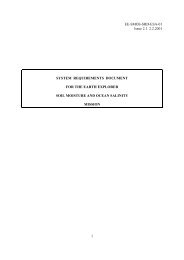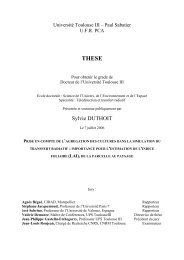Algorithm Theoretical Based Document (ATBD) - CESBIO
Algorithm Theoretical Based Document (ATBD) - CESBIO
Algorithm Theoretical Based Document (ATBD) - CESBIO
You also want an ePaper? Increase the reach of your titles
YUMPU automatically turns print PDFs into web optimized ePapers that Google loves.
SO-TN-ESL-SM-GS-0001<br />
Issue 1.a<br />
Date: 31/08/2006<br />
SMOS level 2 processor<br />
Soil moisture <strong>ATBD</strong><br />
assume that below some fractional area, influence will be negligible. It is also worth noting that rocks and the like are<br />
usually on barren areas or in mountains etc… and thus of concern for only a limited number of cases. Effectively,<br />
problems may arise only when a significant amount of surface is covered with rocks (boulders, steep high mountains,<br />
cliffs), or when the dry soils or rocky outcrops have very specific signatures. In all those latter cases, the issue will only<br />
complicate existing issues and such cases will probably have to be flagged and the algorithm directed towards dielectric<br />
constant values estimation.<br />
In [68] permittivity values are given for rocks at 400 MHz and 35 GHz. They range from 2.4 to 9.6. Approximate<br />
expressions do exist (see Weiner’s model for powdered rocks for instance) for rocks but it does not seem worth the<br />
effort to implement in the level 2 algorithm for the reasons given above. However a default dielectric constant<br />
ε rock should be provided. We suggest (see UPF)<br />
ε rock ’ = 5.7 ; ε rock ” = 0.074<br />
3.1.4.1.3 Other specific soil surface cases<br />
In some instances the surface will be affected by other factors such as mineral deposits, salted residues (salt lakes for<br />
instance) or surface with very specific dielectric constants.<br />
With current knowledge, this can only be addressed with the dielectric approach. Actually below 10 GHz the ionic<br />
conductivity of saline water has a marked effect on the loss factor and this is used in SMOS for salinity retrievals.<br />
However the exact form of the dependence of the dielectric constant on soil salinity is not well understood, due to the<br />
very sparse measurements available.<br />
3.1.4.2 Frozen soils and ice<br />
• Frozen soils cover large areas at high latitudes (and sometimes altitudes). At mid latitude, frozen soil can also<br />
be expected in winter, especially for the morning orbit. Experience shows that the dielectric properties of<br />
frozen soil are very close to those of dry soil, while vegetation is almost fully transparent [72]. It is often<br />
considered that for frozen soils the dielectric constant can be written [73]<br />
ε frz = 5 + i 0.5 Eq 42<br />
It can thus be expected that the algorithm will deliver a “very dry bare soil” output when soil is frozen. The<br />
presence of frozen soil will be identified by this “very dry bare soil” result from the retrieval when other variables<br />
such as air temperature, vegetation cover, and retrieved soil temperature are consistent. It should also be borne in<br />
mind that frozen ground often shows extreme spatial heterogeneity, complicating the matter. A more sophisticated<br />
expression I sgiven for frozen soils in [74] but it was deemed to complex (in terms of necessary input data to be<br />
used in the constext of the L2 SM retrieval algorithm.<br />
We consequently believe that the algorithm used over frozen ground might either be the standard one (nominal<br />
case) with possibly the adding of a flag (when temperatures are low etc) or dielectric constant retrieval one.<br />
Effectively, when everything is frozen things should work nominally. Problems may occur when the area is<br />
partially frozen (and patchy surface either dry or wet!). Then the frozen surface is modelled with the default frozen<br />
ground model and the complementary area undergoes the decision tree retrieval routine.<br />
• The areas of permanent ice/dry snow are known, and will be masked out, so that only the dielectric constant is<br />
retrieved. (e.g., Greenland, Antarctica,…). For other areas or partial ice (mountains, cold lakes) the idea is that<br />
above a given threshold the dielectric constant could be retrieved.<br />
It can be noted however that ice is rather transparent, with ε ice " being very small (ε ice "= 0.1 in [74] for pure ice) as<br />
given in [75]:<br />
ε ice ≈ 3.17 + i ε ice " Eq 43<br />
3.1.4.3 Snow<br />
Snow covers about 40% of the Northern hemisphere land mass seasonally, but has very different dielectric properties<br />
depending on its history. Fresh, dry snow is transparent to microwave radiation, however as snow melts its dielectric<br />
constant increases dependent upon snow grain size and liquid water content and may be totally opaque (at T e ≅ 273 K)<br />
when wet. Consequently, the effects of snow are too complicated to be incorporated into the currently-proposed<br />
algorithm, and areas with significant snow coverage other than dry snow must be considered as irretrievable, for<br />
estimation of only the dielectric constant. The issue will be in identifying and flagging the snow covered areas.<br />
See section 3.7 for future developments.<br />
.<br />
45





